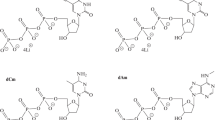Summary
CV-1 cells productively infected with SV40 contain viral DNA which is covalently linked with the host cell DNA. These linear duplex viral-host DNA molecules are replicated during the infectious cycle. They can be selectively isolated and purified by two successive cycles of DNA-DNA hybridization and elution steps using first CV-1 cell and then SV40-DNA immobilized on filters. In an attempt to clarify the nature of the host DNA sequences neighbouring the viral DNA it was found that reiterated host DNA must be within the range of 800 bases from the viral sequences. Reassociation kinetics and treatment of the reassociated viral-host DNA sequences with single strand-specific S1 nuclease have shown that unique host DNA sequences are always present in close neighbourhood of the viral DNA. Most of the SV40 DNA sequences are probably integrated as fragments of subgenomic length.
Zusammenfassung
Produktiv mit SV40 infizierte CV-1 Zellen enthalten kovalent mit der Wirtszell-DNS verbundene Virus-DNS. Die linearen Doppelstrang Virus-Zell-DNS Moleküle werden während des Infektionszyklus repliziert. Sie können mittels zweier DNS-DNS-Hybridisierungs- und Elutionsschritte selektiv isoliert und gereinigt werden. Dabei wird zuerst auf dem Filter immobilisierte CV-1 Zell-DNS und im zweiten Hybridisierungsexperiment immobilisierte SV40 DNS eingesetzt. Bei der Suche nach der Natur des Integrationsortes zeigte sich, daß innerhalb eines Bereiches von 800 Basen reiterierte Zell-DNS-Sequenzen entweder unmittelbar an die virale DNS angrenzen, oder aber in enger Nachbarschaft befindlich sein müssen. Reassoziierungskinetiken und die Behandlung der reassoziierten Virus-Zell-DNA-Sequenzen mit Einzelstrang-spezifischer S1 Nuclease haben gezeigt, daß auch „unique” Zell-DNS-Sequenzen in enger Nachbarschaft der Virus-DNS vorkommen. Die meisten der Virus-DNS-Sequenzen Schemen in Form von Fragmenten subgenomischer Größe integriert zu sein.
Similar content being viewed by others
References
Babiuk,L.A., Hudson,J.B.: Integration of polyoma virus DNA into mammalian genomes. Biochem. Biophys. Res. Commun. 47, 111–118 (1972)
Cuzin,F., Vogt,M., Dieckmann,M., Berg,P.: Induction of virus multiplication in 3T3 cells transformed by a thermosensitive mutant of polyoma virus. II. Formation of oligomeric polyoma DNA molecules. J. molec. Biol. 47, 317–333 (1970)
Davidson,E.H.,Hough,B.R., Amenson,C.S., Britten,R. J.: General interspersion of repetitive with non-repetitive sequence elements in the DNA of Xenopus. J. molec. Biol. 77, 1–23 (1973)
Gelb,L.D., Martin,M.A.: Simian virus 40 DNA integration within the genome of virus-transformed mammalian cells. Virology 51, 351–357 (1973)
Girardi,A.J.: Prevention of SV40 virus oncogenesis in hamsters. I. Tumor resistance induced by human cells transformed by SV40. Proc. nat. Acad. Sci. (Wash.) 54, 445–451 (1965)
Hirai,K., Defendi,V.: Integration of simian virus 40 deoxyribonucleic acid into the deoxyribonucleid acid of permissive monkey kidney cells. J. Virol. 9, 705–707 (1972)
Hirt,B.: Selective extraction of polyoma DNA from infected mouse cell culture. J. molec. Biol. 26, 365–369 (1967)
Lavi,S., Winocour,E.: Acquisition of sequences homologous to host deoxyribonucleic acid by closed circular simian virus 40 deoxyribonucleic acid. J. Virol. 9, 309–316 (1972)
Lee,C.S., Thomas,C.A.,Jr.: Formation of rings from Drosophila DNA fragments. J. molec. Biol. 77, 25–42 (1973)
Martin,M.A., Gelb,L.D., Fareed,G.C., Milstien,J.B.: Reassortment of simian virus 40 DNA during serial undiluted passage. J. Virol. 12, 748–757 (1973)
Ralph,R.K., Colter,J.S.: Evidence for the integration of polyoma virus DNA in a lytic system. Virology 48, 49–58 (1972)
Thomas,C.A.,Jr., Dancis,B.M.: Appendix. Lee,C.S., Thomas,C.A.,Jr.: Ring stability. J. molec. Biol. 77, 43–55 (1973)
Vogt,V.M.: Purification and further properties of single-strand-specific nuclease from Aspergillus oryzae. Europ. J. Biochem. 33, 192–200 (1973)
Waldeck,W., Kammer,K., Sauer,G.: Preferential integration of simian virus 40 deoxyribonucleic acid into a particular size class of CV-1 cell deoxyribonucleic acid. Virology 54, 452–464 (1973)
Wu,J.R., Hurn,J., Bonner,J.: Size and distribution of the repetitive segments of the Drosophila genome. J. molec. Biol. 64, 211–219 (1972)
Author information
Authors and Affiliations
Rights and permissions
About this article
Cite this article
Kuhn, C., Waldeck, W. & Sauer, G. Size and distribution of SV 40 DNA sequences covalently linked with the DNA of permissive mammalian cells. Z. Krebsforsch. 83, 65–79 (1975). https://doi.org/10.1007/BF00284402
Received:
Accepted:
Issue Date:
DOI: https://doi.org/10.1007/BF00284402




